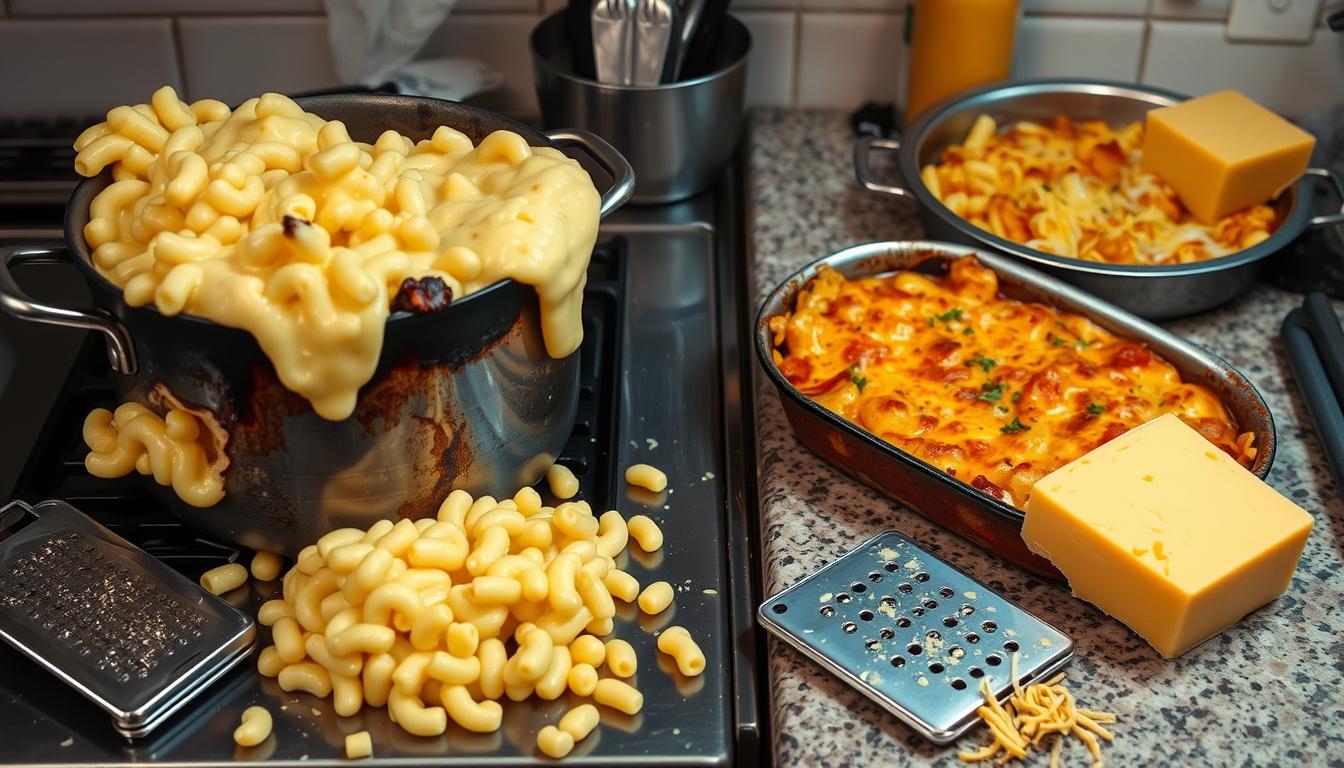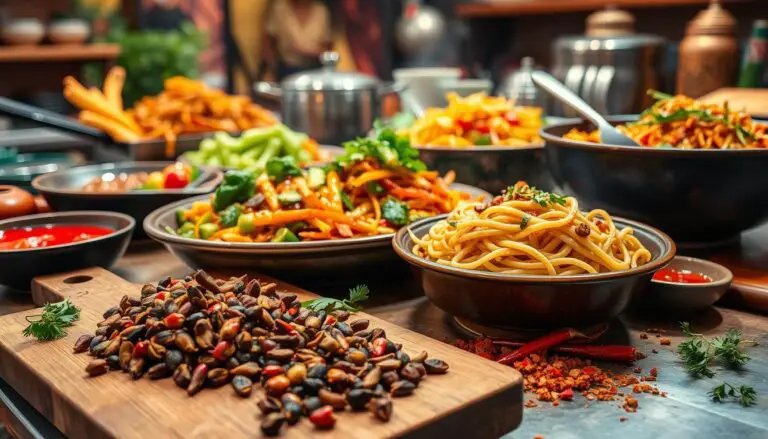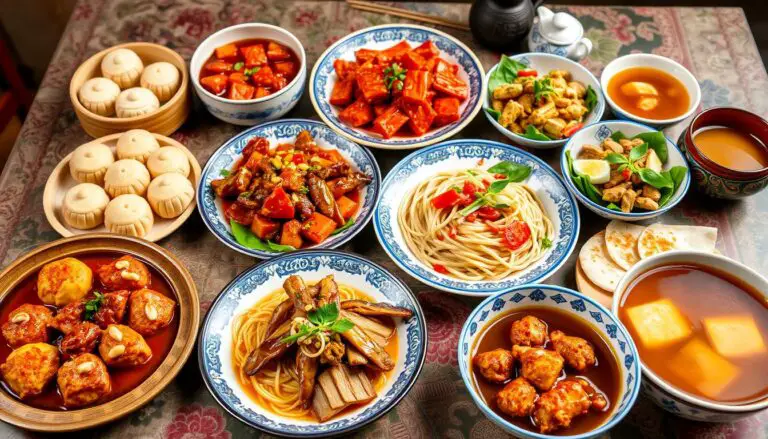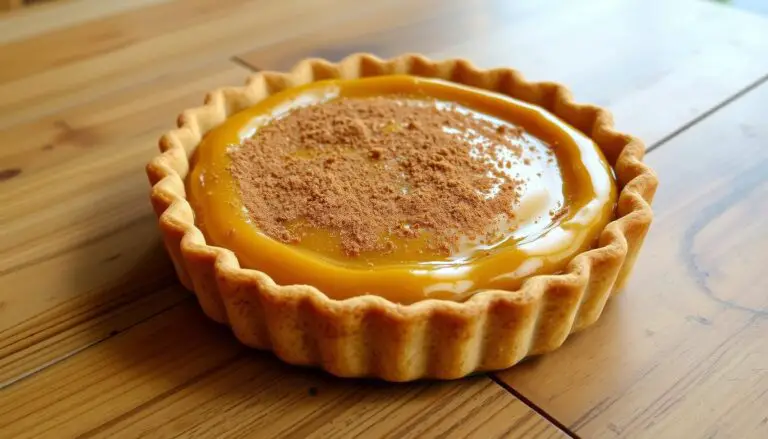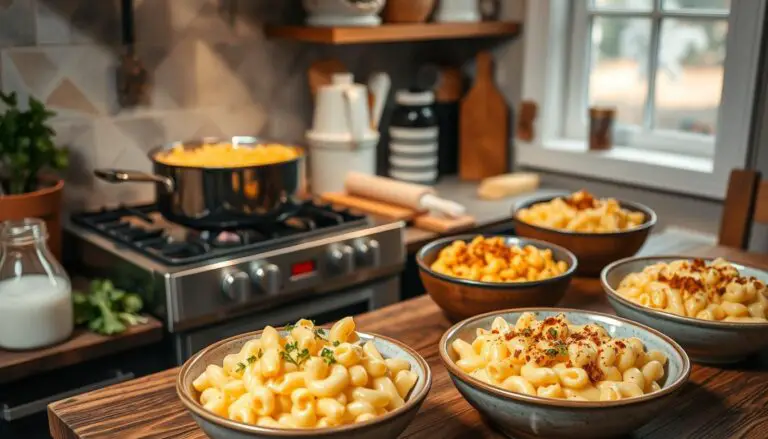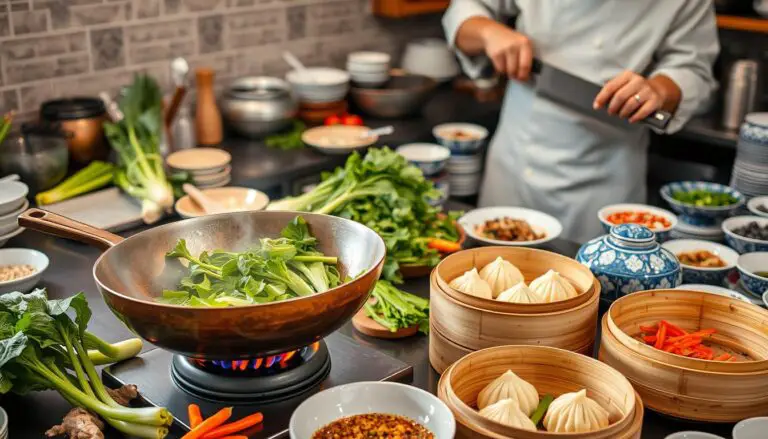Avoid These Mistakes When Making Mac and Cheese
Ever wondered why your homemade mac and cheese doesn’t match the boxed kind? This dish has ancient Roman roots and became popular in America in the 18th century. Yet, many struggle to make it right at home. Knowing what not to do is key to making it a true comfort food.
One big mistake is overcooking the pasta, making it soggy. This happens because the noodles release too much starch, changing the dish’s texture1. Also, the pasta shape matters a lot. Shapes like rigatoni or penne hold sauce better than elbow macaroni2. To make your mac and cheese a hit, avoid these common errors.
Key Takeaways
- Overcooking pasta leads to soggy noodles, a major mac and cheese mistake.
- Choose high-quality cheeses, avoiding processed options for better flavor.
- Experiment with different pasta shapes for optimal cheese sauce retention.
- Baking before serving results in a golden, crispy top without compromising creaminess.
- Proper seasoning throughout the cooking process is crucial for enhanced flavor.
Understanding the Basics of Mac and Cheese
Mac and cheese is a favorite in American cuisine, loved for its taste and simplicity. It’s made with macaroni and a creamy cheese sauce. This dish has ancient roots, becoming a staple in the U.S. over time.
Knowing the basics of mac and cheese can make cooking it better. Start with good ingredients, like a mix of cheeses like cheddar, Gruyère, or fontina. High-quality cheese makes the sauce richer and more flavorful. Freshly grated cheese is best; pre-shredded cheese can make the sauce grainy3.
Creating a great cheese sauce starts with a béchamel base. This is a mix of butter, flour, and milk. Baking the mac and cheese makes it even better, as the pasta soaks up the sauce and gets a crispy top4. Learning these basics helps you avoid mistakes and enjoy delicious mac and cheese every time.
| Nutritional Information | Per Serving |
|---|---|
| Calories | 451 kcal |
| Carbohydrates | 55 g |
| Protein | 20 g |
| Fat | 16 g |
| Saturated Fat | 10 g |
| Cholesterol | 48 mg |
| Sodium | 661 mg |
| Potassium | 282 mg |
| Fiber | 2 g |
| Sugar | 6 g |
| Vitamin A | 510 IU |
| Calcium | 375 mg |
| Iron | 1.5 mg |
With these basics, you’re ready to make a delicious mac and cheese. Check out more tips and recipes for the best homemade mac and cheese recipe you’ll love5.
The Importance of Choosing Quality Ingredients
Choosing the right ingredients is key to a great mac and cheese. Using sharp cheddar or Gruyère cheese makes the dish taste better and feel creamier. Fresh ingredients make the meal richer and more satisfying.
Homemade mac and cheese beats store-bought versions in taste and health. It’s better to buy a block of cheese instead of pre-shredded. This avoids anti-caking agents that can ruin the texture6.
There are many cheeses you can mix for a unique taste. Try gouda, Monterey Jack, colby jack, or American cheese. Pairing the right pasta, like shells or cavatappi, helps the sauce stick better and makes each bite enjoyable7. Milk and butter are crucial for that creamy texture we all love.
What Not to Do When Making Mac and Cheese?
Making the perfect mac and cheese means avoiding common mistakes. Overcooking pasta and picking the wrong cheese can ruin it. Knowing how to avoid these errors is key to a creamy, flavorful dish.
Overcooking Your Pasta
Overcooking pasta is a big mistake that makes it mushy. This happens when noodles boil too long. They should be al dente, with a firm bite.
Even after draining, pasta still cooks a bit. So, aim for just shy of fully cooked. If it’s overcooked, it turns gluey and inedible, ruining your dish8.
Using the Wrong Type of Cheese
Picking the right cheese is crucial. Using processed cheese can make the flavor bland and the sauce grainy. Cheeses with additives like cellulose and calcium sulfate don’t melt well9.
Instead, use freshly grated cheese for a richer taste. Avoid very aged cheeses because they don’t melt well and can make the sauce look bad8. Mixing different cheeses is a good idea for the best flavor and texture.
| Mistakes | Consequences | Solutions |
|---|---|---|
| Overcooking Pasta | Mushy texture | Cook al dente; monitor closely |
| Wrong Cheese Choice | Grainy cheese sauce | Use freshly grated cheese |
| Over-Stirring | Clumpy texture | Stir gently; balance incorporation |
| High-Processed Cheese | Bland flavor | Choose real cheese for sauces |
By making these changes, you can avoid common mistakes and make a delicious mac and cheese that everyone will love9.
Mastering the Béchamel Sauce
Making a perfect béchamel sauce is key for a rich, creamy mac and cheese. This white sauce is a base for many dishes like macaroni and cheese, lasagna, and gratins10. Knowing how to avoid mistakes, like an undercooked roux, is crucial.
Avoiding an Undercooked Roux
Making a smooth béchamel sauce starts with a roux. This is done by cooking equal parts flour and butter. It’s important to melt the butter slowly over low heat to avoid burning, then whisk in the flour11.
Rushing this step can lead to an undercooked roux, making your sauce gritty. To achieve the right thickness, add milk slowly while stirring constantly10.
Incorporating Dairy the Right Way
To get a creamy béchamel sauce, add milk gradually. This prevents clumps and ensures a smooth sauce11. Season with salt and a bit of nutmeg for extra flavor.
Keep an eye on the sauce and mix well to avoid burning. With practice, you’ll make a sauce that makes mac and cheese irresistible.
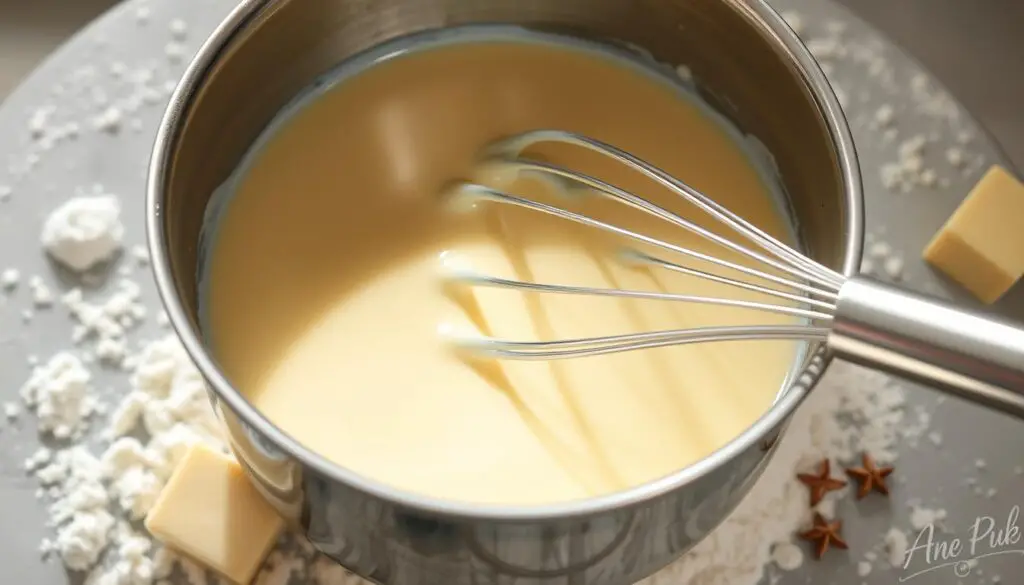
Picking the Right Pasta Shape
The pasta shape you choose greatly affects your mac and cheese experience. Elbow macaroni is a classic favorite, but cavatappi and rigatoni offer new flavors. These shapes look great and hold sauce well, making every bite rich and tasty. Elbow macaroni cooks quickly, in 6 to 8 minutes, perfect for fast cheesy meals12.
Shell pasta looks like mini cheese cups and holds sauce well13. You can find standard shells easily, but chiocciole, like snail shells, might be harder to find13. Cavatappi and rigatoni are great for extra sauce because of their tubular shape1314.
Rigatoni takes about 11 to 13 minutes to cook, making it perfect for thick sauces12. Remember, different pasta shapes work best with specific sauces. Choosing the right pasta can really improve your meal14.
Common Cheese Mistakes to Avoid
When making the perfect mac and cheese, avoiding cheese mistakes is key. Choosing the right cheese is crucial for the right taste and texture.
Shying Away from Freshly Grated Cheese
Many people don’t use freshly grated cheese. Pre-shredded cheese can have additives like cellulose. This can make the sauce gritty and affect the taste15.
Using freshly grated cheese improves flavor and texture. The FDA says cheese should have 2 to 4 percent cellulose. But some brands have more, like Walmart and Jewel-Osco16. Choosing fresh cheese can make your mac and cheese stand out.
Overusing Strong Cheeses
Strong cheeses, like Sharp Cheddar, melt well but should be used wisely. Too much can overpower the dish17. A mix of cheeses is better for a balanced taste.
Creamy cheeses, like Brie or Goat Cheese, add variety without being too strong17. Knowing how each cheese works helps create a better mac and cheese.
Seasoning Your Dish Properly
Seasoning your mac and cheese right is key to great taste. Many cooks forget to season the béchamel or pasta water well. This can make the dish taste dull.
Using the right spices is crucial. Kosher salt is a good choice because it dissolves quickly. Black pepper adds a nice kick, and a bit of nutmeg enhances the cheese’s richness. These seasonings are important because they bring out the dish’s creaminess.
Under or Over-Seasoning
Getting the seasoning just right is vital. Too little seasoning makes the mac and cheese taste bland. Too much seasoning can overwhelm the dish, hiding the cheese’s flavor.
The type of cheese used affects how seasoning is absorbed. Classic medium cheddar is a good base, with funk cheeses like Gruyere or Fontina adding depth. The right seasoning can turn a simple dish into a standout meal, perfect with various sides.
Choosing the Right Seasoning Blend
Choosing the right seasoning blend is important. Dry mustard and smoked paprika, along with salt and pepper, create a rich flavor. Nutmeg adds a warm, spicy touch without overpowering.
Using high-quality cheese is also key. Freshly grated cheese melts better, making the dish creamier. Thoughtful seasoning choices can make your mac and cheese an impressive main dish, especially with classic pairings like pulled pork or oven-baked salmon.
Balancing the Cooking Techniques
Choosing the right cooking method is key to making perfect mac and cheese. Baking and stovetop methods each have their own benefits. Baking gives a crispy top that contrasts with the creamy inside. Stovetop cooking is quicker and keeps the dish moist.
Baking vs. Stovetop Cooking
Baking creates a golden crust on top of the mac and cheese. It involves preheating the oven to 350°F and baking for about 25 minutes. Then, a quick broil adds that crispy topping18.
Stovetop mac and cheese is faster, making it convenient. It doesn’t need an oven18. Using room temperature ingredients and fresh cheese improves the dish, no matter the method18.
The mix of ingredients is also crucial. Sharp cheddar, mild cheddar, muenster, and Monterey Jack cheeses add depth of flavor18. Letting the dish rest for 5-10 minutes after cooking helps it set. This makes it easier to serve18.
Mac and cheese can be tailored to different tastes. Whether you prefer the richness of baking or the quickness of stovetop, finding a balance in these techniques makes for a comforting meal.
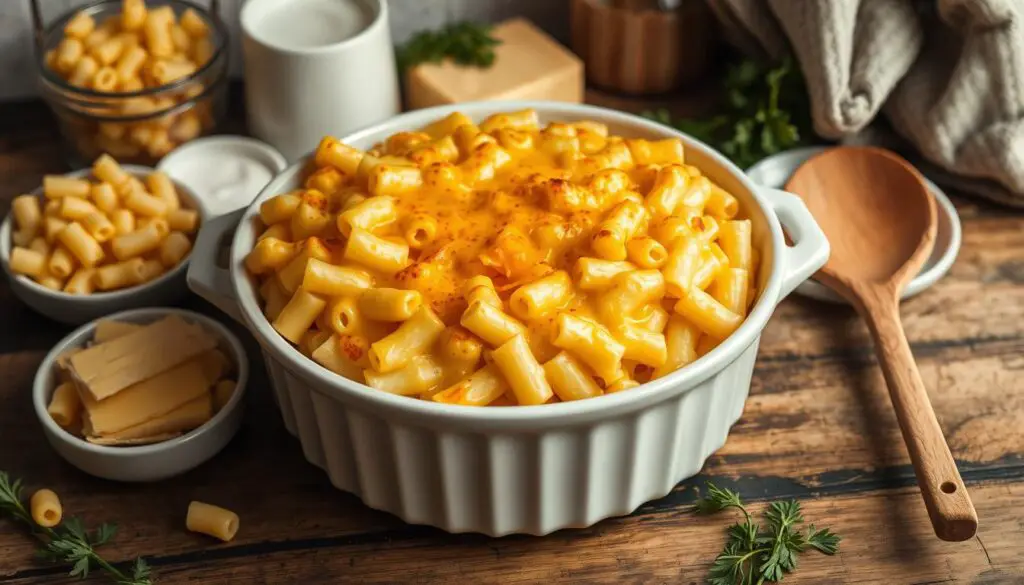
Enhancing Flavor with Toppings
Toppings are key to making mac and cheese better. Without them, it’s just plain. Soft cheeses are great, but crunchy toppings add something special. Crushed Cheez-Its or crispy bacon can make a big difference.
Traditional breadcrumbs also add a nice crunch. This makes the dish more enjoyable to eat.
Not Adding Toppings
Mac and cheese without toppings feels incomplete. Even a small addition can change everything. Surveys show that toppings are very important.
- 64.8% of voters prefer hot sauce or meat options as their toppings of choice19.
- Only 22.2% consider using extra carbs like breadcrumbs, missing out on the opportunity for added texture19.
This highlights how crucial the right toppings are for flavor.
Choosing the Wrong Topping
Choosing the wrong toppings can ruin the dish. Some like classic cheese, while others prefer Doritos or seasoned meats. Finding the right balance is key.
Many people add extra cheese, with 31.5% choosing different cheeses19. Almost 25.9% also add vegetables19.
| Topping Type | Percentage of Preference |
|---|---|
| Hot Sauce | 64.8% |
| Meat | 64.8% |
| Vegetables | 25.9% |
| Additional Cheese | 31.5% |
| Additional Carbs | 22.2% |
The right toppings can elevate mac and cheese to gourmet levels. For more tips, check out this guide20.
Conclusion
Making the perfect mac and cheese is all about avoiding common mistakes. Choose the best ingredients and learn the right cooking methods. This way, you can turn a simple dish into a masterpiece.
Every step in the process is crucial. It helps you grow as a cook and understand flavors better.
Moskin’s no-boil mac and cheese recipe is a hit, with a five-star rating from 15,000 reviews21. Tini’s viral TikTok mac and cheese got over 94 million views in 202321. Budget Bytes’ recipe is simple, using just 2 ¼ cups of cheese and ½ pound of pasta21.
Using quality ingredients like medium shells pasta and Velveeta cheese can make cooking faster. You can make six servings in just 15 minutes22. Remembering these tips will help you improve your mac and cheese game. It will inspire you to try new things and get better at cooking.

